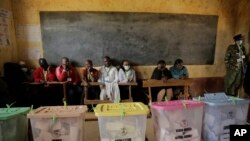The nation's attention turned Tuesday night to classrooms and other vote-counting locations across the country as paper ballots were inspected one by one.
Results must be announced within a week, but impatience is expected if they don’t come before this weekend. “What we want to try to avoid is a long period of anxiety, of suspense,” said Bruce Golding, who leads the Commonwealth election observer group.
To win outright, a candidate needs more than half of all votes and at least 25% of the votes in more than half of Kenya’s 47 counties. No outright winner means a runoff election within 30 days.
The August 9 election marks the end of an unusual campaign where the top candidates are Raila Odinga, a democracy campaigner who has vied for the presidency for a quarter-century, and 55-year-old Deputy President William Ruto, who has stressed his journey from a humble childhood to appeal to struggling Kenyans long accustomed to political dynasties.
Issues such as widespread corruption could be of greater importance than the ethnic tensions that have marked past votes with sometimes deadly results.
The Independent Electoral and Boundaries Commission estimated that final turnout would be above 60%, far lower than the 80% in the 2017 election. That would make it Kenya's lowest turnout in 15 or even 20 years. The electoral commission signed up less than half of the new voters it had hoped for, just 2.5 million.
More than 6.5 million people had voted by midday, or about 30% of the 22 million registered.
The election was considered close but calm as some voters cited little hope of real change.
Kenya, East Africa's economic hub, could see a presidential runoff for the first time depending on the count. If necessary, it would be held within 30 days of August 9 if none of the four contenders for the top job get more than half of the votes cast along with at least 25 percent of the votes cast in 24 counties.







